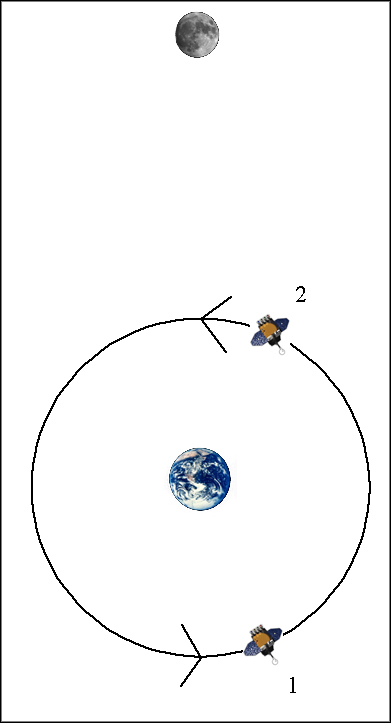This is pretty wild: a partial solar eclipse on March 4, 2011 as seen from NASA’s Solar Dynamics Observatory! Watch as the Moon slips in front of the face of the Sun in this video:
Cool! In this far-ultraviolet view, you can see magnetic activity on the Sun’s surface, like arcing gas eruptions and sunspots (which are dark in visible light, but very bright in the UV), and the roiling, bubbling motion as pockets of hot solar gas rise and fall. Then, suddenly, the Moon makes its appearance!
When I first saw this, I was surprised the Moon appeared to reverse direction. But after a moment’s thought I figured it out: parallax! Here’s how it works:
 On the right is a diagram (not to scale, duh) I put together to illustrate the situation. SDO orbits the Earth, and I drew it so that it orbits counterclockwise. When SDO is at the bottom of the diagram, it’s moving to the right (position 1). A little while later (position 2) it’s moving to the left.
On the right is a diagram (not to scale, duh) I put together to illustrate the situation. SDO orbits the Earth, and I drew it so that it orbits counterclockwise. When SDO is at the bottom of the diagram, it’s moving to the right (position 1). A little while later (position 2) it’s moving to the left.
Now imagine the Sun is way off the top of the diagram. SDO stares at the Sun, locked onto it, so it doesn’t appear to move as SDO orbits the Earth. But the Moon is much closer, and is greatly affected by SDO’s orbital motion. When SDO is at position 1, to it the Moon appears to be moving to the left. When SDO is at position 2, the Moon looks like it’s moving to the right!
So at different points in its orbit, SDO sees the Moon moving in opposite directions. The point where the Moon’s direction just switches direction is about when the Earth, SDO, and the Moon make a right angle, at about the 3:00 position in its orbit as I’ve drawn it here (and again at 9:00). When SDO saw the partial eclipse, it must have just been at the point in its orbit where the Moon switched directions. That’s why in the video you see it moving one way, slow, stop, then reverse.
Pretty cool, huh? It goes to show you that sometimes things don’t happen the way you expect, but if you’re familiar with the situation a logical explanation can be found.
Science!
Image credit: NASA/SDO. Animation made using a very cool solar viewer called Helioviewer.
Related posts:
- Incredible solar flare video
- KaBLAM! Footage of the X-class solar flare
- First Earthward-heading solar flare of the cycle
- SDO lunar transit: now with video